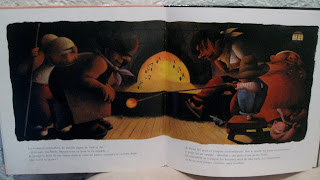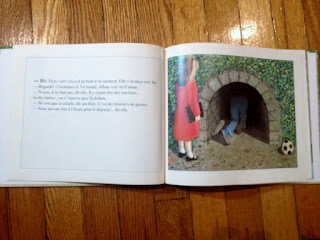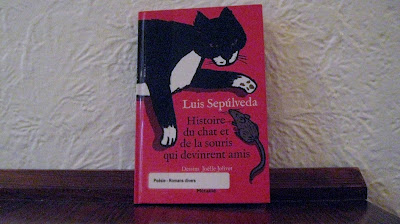AUTHOR Rudyard Kipling
EDITIONS British Library Publishing
COUNTRY United Kingdom
DATE 2010
APPROXIMATE AGE starting 5
COMMENTS
- STORY
The story is from the collection " Just So Stories " by Rudyard Kipling. This tale traces the myth of the domestication of wild animals by humans. Several animals are represented: the dog, the horse and the cow. The cat is the only animal with cunning and intelligence allow him to take advantage of his situation.
- CHARACTERS
The characters represented are wild cat, wild dog, wild horse and wild cow, and a woman and a man. Each character appears progressively in the story. Interactions mainly pass between the woman and each animal.
- DESIGNS
The illustrations were made by Leah Weber. The illustrations are very detailed , the main colors are green , beige and red.
This illustrator works mainly for the youth press and publishing.
http://www.lecrayonnocturne.com/index.php
RATES : *****
Personnal comments : This kind of tale is one that I prefer. Unfortunately, I couldn't read it to children as they were too young. However, I advise all those interested in myths and legends and moral stories to read "Just so stories."
(français)
TITRE « Le chat qui s'en va tout seul»
AUTEUR Rudyard Kipling
EDITIONS Le chant du monde
PAYS France
DATE 2007
ÂGE APPROXIMATIF dès 5 ans
COMMENTAIRES
- HISTOIRE :
L'histoire est tirée du recueil de nouvelles « Histoires comme ça » de Rudyard Kipling.
Ce conte-nouvelle retrace le mythe de la domestication des animaux sauvages par les hommes. Plusieurs animaux sont représentés : le chien, le cheval et la vache. Le chat est le seul animal dont la ruse et l'intelligence lui permettra de tirer profit de sa situation.
- PERSONNAGES :
Les personnages représentés sont le chat sauvage, le chien sauvage, le cheval sauvage et la vache sauvage, et l'homme et la femme. Chaque personnage apparaît au fur et à mesure dans l'histoire. Les interactions se passent essentiellement entre la femme et chacun des animaux.
- ILLUSTRATIONS :
Les illustrations ont été faites par Léa Weber. Les illustrations sont très détaillées, les couleurs principales sont le vert, le beige et le rouge.
Cette illustratrice travaille essentiellement pour la presse jeunesse et l'édition.
http://www.lecrayonnocturne.com/index.php
- APPRÉCIATION : *****
Commentaires personnels : Les contes-nouvelles sont l'un des types de contes que je préfère. Je n'ai malheureusement pas pu le présenter à des enfants car trop jeunes. Par contre, je conseillerai à toutes personnes intéressées par les mythes et légendes et les morales de lire « Histoires comme ça ».

















